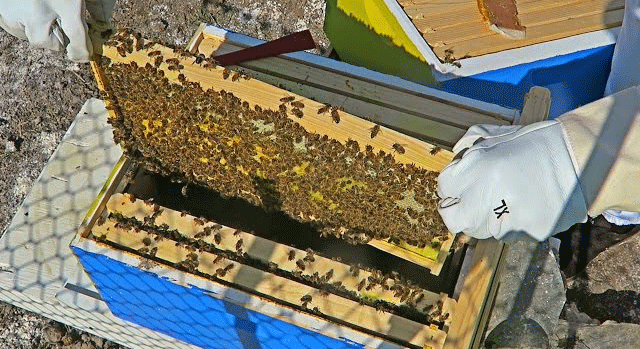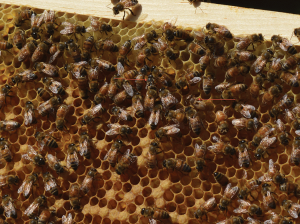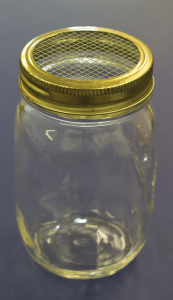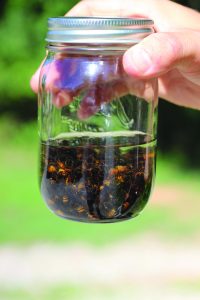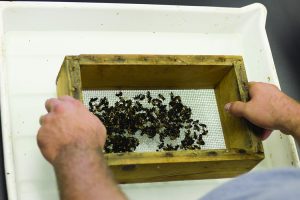This past June, Brushy Mountain Bee Farm had a Field Day,which attracted about 150 participants. I was invited to lecture on several topics but more importantly, it gave me the opportunity to meet a whole host of new beekeepers and hang out with my friends Shane Gebauer, Candy Treadaway, Daniel Roath, and Steve and Sandy Forrest. The morning was set aside for lectures, but the afternoon focused more on hands-on sessions, mine in particular having to do with hive inspections for colonies that had had some sort of issue. The colonies set aside for me had been started from South Georgia packages just a few months prior.
That afternoon as I approached the first colony, it was clear to me that something was wrong; few foragers were flying about, and the ones hanging out on the front porch were shiny, black, and shaking. At this point, it was pretty obvious what was going on, but with further inspection, the culprit was revealed. Check out the photos. This is classic Varroa infestation: spotty brood patterns, low adult population, greasy, shiny adult bees, and tiny, weak bees with visible symptoms of deformed wing virus (DWV). This colony is sick, but that didn’t happen over night. It happened over weeks, months, or even years due to mites being allowed to multiply over and over again till the breaking point was reached.
 In the agricultural industry, we call this the economic injury level (EIL), which is defined as “the lowest population density that will cause economic damage.” The EIL is part of the Integrated Pest Management (IPM) strategy. It’s a value – a number – that, if attained by a pest population, will result in economic damage (a loss of yield, produce, a loss of bees). Therefore, the EIL is “a measure against which we evaluate the destructive status and potential of a pest population.”
In the agricultural industry, we call this the economic injury level (EIL), which is defined as “the lowest population density that will cause economic damage.” The EIL is part of the Integrated Pest Management (IPM) strategy. It’s a value – a number – that, if attained by a pest population, will result in economic damage (a loss of yield, produce, a loss of bees). Therefore, the EIL is “a measure against which we evaluate the destructive status and potential of a pest population.”
A lot of words there, but for our purpose of dealing with Varroa mites, we define the EIL as when the population of mites has reached the level where, if left alone, that colony is doomed. And actually, because of the presence of viruses, once the mite levels reach the EIL, it may be too late to save the colony. Therefore, we as beekeepers need to reduce mite populations before they reach the EIL. We need to act when population levels reach the economic threshold (ET). And if we intervene in the health and welfare of our colony at that point, we may still have a chance to save it.
The colony that I inspected that day at Brushy Mountain Bee Farm is more than likely not going to survive, even if it ends up receiving treatment. It will, actually, take several steps to save it, and even then, the effort may still be in vein. If it were my colony, I would do anything I could to help it survive or at least reduce its suffering. First, let me explain how I would try to keep the colony alive, and in next month’s issue, I’ll explain the importance of why.
The first thing we need to do is get the mite population down by treating it with a miticide. Since it’s Summer and temperatures are hovering in the upper 90s, I would use Api-Guard, a thymol-based product that can be used when temperatures are high. However, since this particular colony is so weak, I would not use a full dose.
Next, I would switch the placement of the weak colony with a stronger colony. In other words, since there are several colonies in this apiary, I would move the weak colony to where the strong colony was and move the strong colony to where the weaker colony stood. This will use the stronger colony’s incoming foragers to help boost the population of the weaker colony.
Then, I would add a few frames of emerging brood from another strong colony. And, if food stores are low, I’d add feed or frames of capped honey if available. But be careful here. Feeding weak colonies can encourage robbing, so I recommend using internal feeders like jars or buckets. And, finally, I would treat every single colony in that apiary. Here’s why.
I’m very compassionate when it comes to any living thing that’s under my watch. A bird, a plant. a dog, a cat, a tree, a bee, and even those sea monkeys I used to have as a kid. Okay, so maybe I’m too compassionate for my own good, but my point is that I don’t want to see anything suffer. And, like I said, those poor bees were suffering.
“These are bees that will remain alive in the hive from Fall to Spring. These long-lived bees are the reason colonies are able to overwinter.”
So when the students at the field day and myself saw that the colony was infested with mites, saw the suffering caused by too many mites, we all wanted to save them, right then and there. We wanted to get them cleaned of mites. That’s important, yes, but there was another reason we needed to help this colony (even though it might not have a chance in hell): if we don’t kill these mites, they will infest other colonies.
As colonies collapse, those resident bees drift into other colonies with infesting mites still attached. And as neighboring bees start to rob out the dying colony, mites jump onto them, getting a free ride back to the colony next door. Not the best situation especially if the colonies being invaded had low mite counts to begin with, or higher tolerance to mites. We will cover this in more detail next month, since now, we need to focus on getting mite levels down so our bees have a chance of surviving the Winter.
Another option for treating this colony or others during the summer months is by vaporizing with oxalic acid. Oxalic acid is the newest miticide that’s been approved for use in honey bee colonies. There are several ways to apply this product: either through a sugar solution by trickling (drizzling), spraying or by vaporization. Since the trickle method can only be used during the cold months while the bees are in a tight cluster, we will discuss this procedure at a later date. And spraying the bees with a diluted sugar solution is only recommended for use on package bees that have been heavily fed prior to application, so we will discuss that method later as well. The method we are interested in right now is vaporization of the oxalic acid using a vaporizing wand or vaporizer. Let’s review this quickly.
When oxalic acid is heated, it creates a vapor that is deadly to mites. There are various vaporizers available for sale, but I’d be careful of where you decide to buy one. Lots of folks are making these wands now, and some don’t work so well. Just be sure you are buying one from a reputable source. Lots of fly-by nighters out there, so watch your back. Now, back to your regularly scheduled program.
These vaporizing wands are inserted into the entrance of a hive and connected to a power source (such as a battery), which then heats the metal plate, melting the oxalic and creating a vapor. Brushy Mountain Bee Farm has some great information about using oxalic acid on their website, which I would recommend you read prior to using this product.
http://blog.brushymountainbeefarm.com/2015/09/oxalic-acid-faqs.html
You don’t want to hurt yourself or your bees. Beekeeping is supposed to be fun, right?
Now, over the years, beekeepers have been telling me how vaporizing with oxalic acid three times, seven days apart, even while brood is present, is cleaning up their bees and keeping mite populations at bay. Here we go. This is why I love beekeepers: beekeepers are always thinking outside the box. They’re always trying something new, always inventing some new gadget. With that said, I am skeptical of this method of treatment since brood is almost always present in the summer months, and oxalic acid will NOT penetrate their wax cappings, therefore the mites inside the cells are protected from the vapor. And since oxalic acid is a “flash treatment” and only lasts for a short spell inside the hive, mites emerging from cells about an hour after treatment and for the next seven days will NOT be affected by the vapor. This is why I hesitate on recommending this form of treatment regimen when brood is present.
So, when my South Georgian beekeeping buddy Shearer Turton told me he was going to compare oxalic acid using the method above to an alternative, formic acid, I was ecstatic. According to his results, colonies treated with oxalic acid three times, seven days apart did result in a reduction of mites (you can read his study in this issue). But my questions remain; how well did it work, and how well will it help these colonies in the long run? In other words, have the mite loads lowered enough to prevent the population of mites from rebounding, especially during the critical months prior to winter? When brood is present, the majority of mites will be reproducing and will be doing so under the cappings, inside the cells. Plus, during the warm, summer months, the bees (and the mites feeding on them) are outside the hive foraging. So, what is the percentage of mites actually being exposed to the vapor? That’s what concerns me. That is why I’m very excited to see the results from the data Shearer is collecting now (July). He is doing another round of washes and counting mites to see where mite populations are several months after the oxalic acid treatment. Hopefully, I’ll have numbers to share in October’s issue.
Years ago, we studied the effectiveness of applying powdered sugar to colonies to reduce the number of mites. Our results were very disappointing. We found that powdered sugar works to drop mites off bees, but it wasn’t “strong enough” for treatment. It didn’t drop a large enough percentage of mites to keep those populations from continuing to grow and surpassing the ET, eventually reaching the EIL.
Now, let’s back up a bit. End of Summer, first part of fall in the southeast, and our bees are beginning preparations for Winter. Okay, actually, they’ve been collecting honey and pollen and preparing for Winter all year long, but now they are doing something a little different: they are beginning to rear Winter bees. These are bees that will remain alive in the hive from Fall until Spring. These long-lived bees are the reason colonies are able to overwinter. These bees are also physiologically different from Summer bees due to an increase in their ability to accumulate vitellogenin (a protein) and using it as a food storage reservoir inside their bodies.
The problem arises when the mites are feeding upon the developing Winter bees. It compromises their immune system, thereby allowing viruses to be expressed. Simply put, it makes them sick and unable to survive the long, cold, Winter months. So that beautiful colony that was full of bees and honey in October is not so when you open it up in February. The only thing left is drawn comb, plenty of honey and pollen, and a tiny cluster or no bees at all.
What happened? Did the bees abscond? Nope, not likely in the Fall or Winter. Did they swarm? Nope. Again, not Fall or Winter. Did someone steal the bees? Not likely, since the equipment is still there. Then it must be one of the following: CCD? Cell towers? The government? Alien intervention? Zombie Bees? Global Warming? Right? Nope, none of the above. It’s just plain, old, nasty, blood-sucking, bee-attacking, ectoparasitic-infesting, virus-passing mites. Arrrrgggghhhhh! That awesome colony of bees in October had high mite loads, so the Winter bees had high viral loads reducing their ability to survive. Starting in October, the bees were slowly dying off. A couple hundred here, a couple hundred there, until no bees were left. And since we were tucked away in our warm, toasty homes, we weren’t witnessing the slow passing of the bees.
So it’s time to check your bees and see what sort of numbers flush out. There are two methods for sampling your bees for mites that we recommend: a powdered sugar shake or an alcohol wash. If you’ve never done either of these, you’ll need a quart jar along with several other items depending on the method. To do the powdered sugar shake, you will also need an eight-inch square of hardware cloth in place of the lid in order to shake the mites through. Think canning lids with bands. Next, brush ½ cup of bees (roughly 300 bees) directly off a frame from the upper-most brood box into the quart jar, making sure not to capture the queen. Add a tablespoon of powdered sugar, and shake, rattle, and roll the bees in the sugar for at least 30 seconds, making sure to cover all the bees in sugar. Then, place the jar upside down and shake the mites through the hardware cloth onto a piece of paper so you can count how many fall. Finally, unscrew the band and release the bees back into the hive. Don’t dump them out front since the sugar may attract ants. This is a great method if you only have a few colonies, but for multiple samples, the alcohol wash may be the way to go.
For an alcohol wash, take a quart jar and fill it half way with alcohol or window washing liquid. Same as above, brush ½ cup of bees into the jar and make sure not to brush the queen in. Shake the bees vigorously for several minutes. Set a strainer inside a container, and pour the bees in, collecting the liquid and mites that pass through the holes in the container. Count the bees to make sure you are close to 300, and then count the mites This method has been proven to be the most accurate as far as determining mite numbers, but I sure hate killing those 300 bees. I guess it’s better to lose 300 bees than 30,000. There’s also a new contraption out there called the Varroa EasyCheck, which should be available and will make varroa sampling that much easier. Just Google the name and hopefully the information on how to order it will be there. As of this writing, however, it is not yet available for sale.
Okay, so let’s make some decisions here. If there were three or more mites dislodged from the 300 bees (that’s 1 mite/100 bees), unfortunately the mite population has reached the ET. And since it’s September, we have limited options. At this point we will have to reach for some sort of miticide. It’s too late in the season for drone brood trapping, powdered sugar, resistant/survivor queens, bottom screens, and other IPM options. If you want to ensure the survival of your colonies, you will need to help your bees by getting those mites off of them NOW.
Since it’s September, temperatures are hopefully lowering a little, but here in the South, we can still plan on days in the 90s. It is important that you are watchful of the upcoming weather forecast before applying any miticide. Here at the lab, our first choice is Api-Life Var or Api Guard. They both work wonders for killing mites and they are easy to apply. Again, just follow the directions. There’s also formic acid (Mite Away Quick Strips), which works well, but we have always used a thymol-based product. All three of these along with oxalic acid are CNG (Certified Naturally Grown) approved.
Speaking of oxalic, there may be another option you want to consider, especially here in the South. What if we cage the queen for 14 days, and decide on day 21 to vaporize with oxalic acid? This will force all the mites to go phoretic since there will be no more capped brood for the mites to hide in. By caging the queen for 14 days, we are breaking the brood cycle and causing the colony to be “capless” on day 21. The only problem with this method is having to wait an additional 21 days before you can treat. If mite numbers are high, your colonies may not have time on their side. But if mite numbers are low, then consider this: we are testing this method now, so we should have numbers by the end of the year.
Okay, one more thing to consider then I’ll stop writing, promise. Earlier, I was talking about how bees/mites drift back and forth. Well, if you have more than one colony in your apiary, and, say, one of those colonies has reached the ET. Instead of only treating that one colony, we are now recommending you treat all the colonies in the yard. I know, this is the complete opposite of what we used to say (only treat colonies whose mite levels have reached the ET, blah, blah, blah). But now with new evidence of mite migration from collapsing or infested colonies, it’s time to think of the apiary as the entire colony, as the super organism, so to speak. Again, I plan to go into more detail about this next month.
Next month, next month, always next month. But let’s not put off checking our girls till next month or there may not be any girls to check.
Take care of you and your bees!
Jennifer Berry is the Research Leader at the UGA Bee Lab and beekeeper and queen producer.







